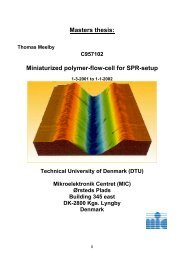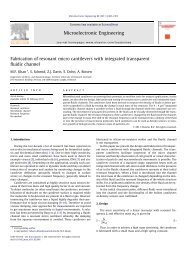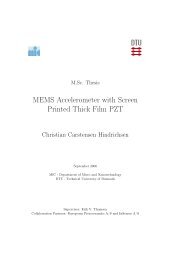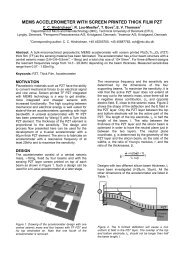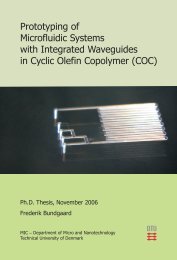C - DTU Nanotech - Danmarks Tekniske Universitet
C - DTU Nanotech - Danmarks Tekniske Universitet
C - DTU Nanotech - Danmarks Tekniske Universitet
You also want an ePaper? Increase the reach of your titles
YUMPU automatically turns print PDFs into web optimized ePapers that Google loves.
5.1 Materials and Methods 31<br />
freezing chamber, to touch the top cover (further described in section 5.2.2). Part 2 could<br />
be used as top cover also, but this top cover had no air gap.<br />
5.1.2 Freezing experiments with PBS–buffer relating to the freezing<br />
chamber design<br />
Chemicals (Vwr)<br />
• 10 mmol PBS–buffer<br />
8 g/l NaCl, 0.2 g/l KCl, 1 g/l Na2HPO4 and 0.2 g/l KH2PO4 in double distilled water<br />
(pH = 7.2)<br />
Equipment<br />
• Pressurized air<br />
• Ice<br />
• Cooling block<br />
• Freezing chambers I–IV<br />
• Power supply IPS2303DD Iso–Tech<br />
• Peltier element TEC 1–1703 Nippon India<br />
• Heat sink grease Circuitworks Chemtronics<br />
Method<br />
Experimental setup (Fig. 5.3): The Peltier element was placed beneath the freezing chamber,<br />
to cool the vessel bottom. On both sides of the element heat sink grease was used for a better<br />
heat conduction. The resulting heat from the Peltier element was dissipated to a cooling<br />
block, which was immersed in ice. The dissipation process was supported by pressurized air<br />
from an air gun, which flowed around the cooling block. A sample at room–temperature<br />
was pipetted into the vessel. In the most experiments the freezing chamber was closed with<br />
a top cover, which had an air gap. The top cover and the freezing chamber were screwed<br />
onto the cooling block, thus the Peltier element was pressed with its cool side to the freezing<br />
chamber and with its hot side to the cooling block.<br />
In the experiments with design I first no top cover, no pressurized air and no ice layer<br />
was used. Additionally the two top covers were tested (see section 5.1.1). The following<br />
experiments were performed:



